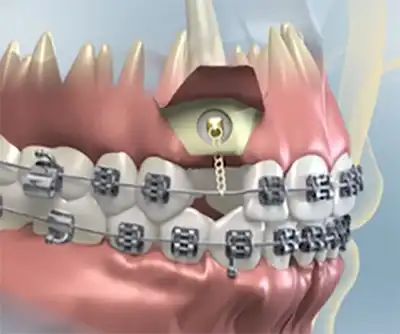Canine Exposure And Bonding
Uncovering the Path to an Aligned Smile | River Forest, La Grange, Berwyn, West Loop, and Elmhurst Dental Practice
Have you or your child been told about an impacted canine tooth? You’re not alone. Canine teeth—those pointed “fang” teeth at the corners of your smile—are crucial for both function and appearance. However, when one doesn’t arrive as expected, it can disrupt alignment, bite, and even your confidence.
At Cameo Dental Specialists, we understand that dental concerns can feel overwhelming. That’s why our expert oral surgeons and orthodontic partners work together to offer a specialized treatment known as canine exposure and bonding. This procedure is designed to help impacted teeth erupt correctly, preserving your natural smile and promoting long-term dental health. Our team provides skillful, compassionate service across all stages of this process.

What Is an Impacted Canine?
The canine tooth—also known as the cuspid—is the longest tooth in the mouth and typically one of the last to erupt. Due to its deep roots and strategic position, it helps guide other teeth into place and supports a strong, functional bite.
In some cases, however, the canine fails to erupt properly and becomes impacted in the gum or bone. This can happen due to overcrowding, late loss of baby teeth, abnormal eruption paths, or even hereditary factors.
An impacted canine may be completely hidden beneath the gums or only partially visible. If left untreated, it can lead to serious issues, such as damage to adjacent teeth, cyst formation, misalignment, or the eventual need for tooth extraction and prosthetic replacement.
Understanding the Canine Exposure and Bonding Procedure
Canine exposure and bonding is a collaborative, minimally invasive oral surgery that helps bring the impacted tooth into its correct position in the dental arch. Here’s a simple breakdown of the process:
- Evaluation and Imaging
The first step is a detailed consultation with one of our oral surgeons, often referred by your orthodontist or general dentist. Advanced imaging techniques—such as panoramic X-rays or 3D scans—are used to determine the exact position of the impacted canine and assess the surrounding teeth and bone structure.
- Surgical Exposure
During this stage, the oral surgeon will gently open the gum tissue over the impacted tooth, exposing the crown (top part of the tooth). If the tooth is located deeper within the bone, a small amount of bone may also be removed to access it safely.
This part of the procedure is typically performed under local anesthesia, sometimes with sedation, depending on the patient’s comfort level and medical history.
- Bonding a Bracket or Chain
Once the tooth is exposed, a small orthodontic bracket or gold chain is attached to it using dental bonding material. This appliance serves as a gentle traction device, enabling the orthodontist to gradually move the tooth into its proper position over several months.
The chain is anchored to the existing orthodontic braces or appliances, and gradual adjustments help guide the tooth without damaging adjacent structures.
How Cameo Dental Specialists Approach the Process
At Cameo Dental Specialists, we take a team-based approach that sets us apart in the field of dental care. We collaborate closely with referring orthodontists and general dentists to ensure a seamless treatment experience for each patient.
Here’s what you can expect from us:
- Comprehensive Consultation: We thoroughly explain your options and the steps involved, answer all your questions, and ensure you feel confident about the procedure.
- Gentle Technique: Our oral surgeons use minimally invasive methods and advanced technology to ensure comfort, precision, and safety.
- Post-Surgical Support: We provide detailed aftercare instructions and are available for follow-up appointments to monitor healing and address any concerns.
- Orthodontic Coordination: Your surgeon and orthodontist work hand-in-hand to track the progress of the canine’s eruption and make necessary adjustments.
Recovery and Aftercare
Healing after canine exposure is typically quick and smooth. Most patients resume normal activities within a day or two. Any minor discomfort or swelling can be easily managed with over-the-counter medication and home care routines, such as cold compresses and soft foods.
Oral hygiene is essential during recovery. We provide guidance on how to gently brush and rinse the area to avoid irritation or infection. Follow-up appointments will ensure proper healing and progress.
Why Early Intervention Matters
Timing plays a significant role in the success of canine exposure and bonding. The earlier an impacted canine is diagnosed—ideally during the early teen years—the better the outcome. Delayed treatment can increase the risk of complications and may reduce the chance of preserving the natural tooth.
This is why regular dental visits and early orthodontic screenings are essential, especially for children and teens.
Serving You Across All Locations
Our dental team proudly serves patients throughout the Chicagoland area in River Forest, La Grange, Berwyn, West Loop, and Elmhurst Dental Practices.
No matter where you’re located, you can expect the same high level of care, comfort, and professionalism at any of our Cameo Dental Specialists locations.
Take the First Step Toward a Healthier Smile
If you or your child has been diagnosed with an impacted canine, don’t wait to explore your options. The experts at Cameo Dental Specialists are here to help guide you through every step of the canine exposure and bonding process. With state-of-the-art facilities, compassionate providers, and a track record of successful outcomes, we’re proud to be a trusted partner in your dental health journey.
Call our River Forest, La Grange, Berwyn, West Loop, or Elmhurst Dental practice today to schedule a consultation. Together, we’ll help you uncover the Path to a confident, healthy smile.